All In One Mushroom Grow Bag: A Guide to Cultivating Gourmet or Exotic Mushrooms
Posted by Troy Cosky, Founder FunGuy Grow Supply on 23rd Feb 2023

Unlock the Secrets of All In One Mushroom Grow Bags: A Comprehensive Guide
Welcome to the world of gourmet and exotic mushroom cultivation! If you've ever been curious about growing your own delicious mushrooms at home, then an All In One Mushroom Grow Bag is your perfect starting point.
These pre-sterilized bags are specifically designed to provide the ideal environment for cultivating a wide range of mushroom varieties with ease. Made from autoclavable polypropylene, these innovative bags come equipped with a gusseted micron filter patch that allows fresh air to enter while keeping contaminants out.
With their convenient size options and smaller micron ratings for added protection against contamination, these bags are a must-have tool for any aspiring mycologist.
In this comprehensive guide, we will explore the basics of All In One Mushroom Grow Bags, including understanding their components, setting them up effectively, and troubleshooting any potential issues that may arise. We will also delve into tips and considerations for optimal growth as well as provide insights on crafting DIY grow bags.
Get ready to embark on an exciting journey into the world of mushroom cultivation with the simplicity and efficiency of All In One Mushroom Grow Bags. Let's dive in!
Key Takeaways
- All in one mushroom grow bags are a convenient solution for cultivating gourmet or exotic mushrooms at home.
- Mushroom grow bags should be selected based on the size of the substrate or grain and the size of the sterilizer.
- Proper ventilation and fresh air exchange are important during both the colonization and fruiting stages of mushroom grow bags.
- The use of filter patch bags with smaller micron ratings can help protect against contamination.
Understanding All In One Mushroom Grow Bags: The Basics
So you want to learn more about all in one mushroom grow bags, huh? Well, buckle up because we're about to dive into the basics of these magical bags that make cultivating gourmet or exotic mushrooms a breeze!
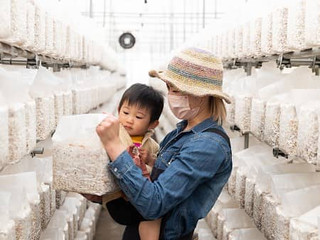
All in one mushroom grow bags are the ultimate solution for anyone looking to grow their own delicious mushrooms. These bags contain everything you need to successfully cultivate mushrooms, including the growing medium and nutrients. With clear instructions provided on the bag, it's easy to follow along and start your mushroom farming journey.
One of the key benefits of using all in one mushroom grow bags is their simplicity. They eliminate the need for complex setups and time-consuming processes typically associated with mushroom cultivation. Simply select your desired bag size, which will depend on the amount of substrate or grain you plan to use, and find a suitable habitat for your bag.
To initiate the growth process, inoculate the bag with a spore syringe, liquid culture, or mycelium on agar. This step is crucial as it introduces the fungal mycelium into the bag, allowing it to colonize and eventually fruit.
Once colonization is complete, it's time for fruiting. To encourage fruiting in your all in one grow bag, cut or puncture holes in the bag for fresh air exchange. Place it in a bright location with high humidity. The mushrooms will then begin to form and mature within a few weeks.
It's important to note that while all in one mushroom grow bags offer convenience and simplicity, they do have some limitations. Yield may be limited compared to other cultivation methods, there is a risk of contamination if proper sterilization techniques are not followed meticulously, and there may be fewer options available for growing different types of mushrooms.
Mushroom Grow Bags: Your Gateway to Successful Cultivation
Discover the essential tool that'll unlock your potential as a skilled cultivator and propel you towards a bountiful harvest: the key to successful mushroom cultivation lies in harnessing the power of carefully chosen grow bags.

Mushroom grow bags are an integral part of cultivating gourmet or exotic mushrooms, especially when it comes to growing cubensis in bags. These specialized bags provide an optimal environment for mushroom growth, ensuring high yields and healthy fruiting.
When it comes to using mushroom grow bags, there are a few key factors to consider. First and foremost is selecting the right type of bag. Mushroom spawn bags are commonly used for inoculating substrate with mushroom mycelium, while substrate bags serve as containers for fully colonized mycelium ready for fruiting. All in one mushroom grow bags combine both functions into a single bag, making them incredibly convenient and user-friendly.
To use mushroom grow bags effectively, start by sterilizing the bag and filling it with your desired mushroom substrate mix or pre-sterilized substrate. Then, introduce your selected strain of mushroom culture into the bag via agar or spore syringe through an injection port or self-healing injection site. After sealing the bag, allow it to incubate at an appropriate temperature until fully colonized.
Once colonization is complete, move the bag to a suitable fruiting environment where fresh air can enter through the built-in filter patch without allowing contaminants inside. Maintain proper humidity levels and provide adequate lighting conditions based on the specific requirements of your chosen mushrooms.
By utilizing these carefully designed grow bags for mushrooms, you can maximize your yield and simplify your cultivation process. With this understanding of how to use mushroom grow bags effectively, let's delve deeper into what exactly these incredible tools are capable of achieving in our next section about 'What are mushroom grow bags?'.
What are Mushroom Grow Bags?
Delve deeper into the world of cultivating delectable fungi with the versatile and essential tool known as the all in one mushroom grow bag. These mushroom bags are pre-sterilized and filled with a growing medium and nutrients, eliminating the need for separate growing mediums. Here's what you need to know about mushroom grow bags:
- Mushroom bags come in various sizes and materials: From polypropylene filter patch bags to gusseted autoclavable bags, there are options to suit your specific needs. The gusseted design allows for holding a large amount of grain or sawdust, while the filter patch allows fresh air to enter without contaminants.
- They're perfect for fruiting mushrooms: Mushroom grow bags can be used as mini fruiting chambers, providing the ideal environment for mushrooms to thrive. You can fruit your mushrooms directly in the bag by cutting or puncturing it for fresh air exchange.
- DIY mushroom grow bags are an option: If you prefer a more hands-on approach, you can make your own mushroom grow bags using materials such as polyethylene. This gives you more control over the size and shape of your bags.
- Spawn bags are commonly used: For larger-scale cultivation or when producing grain spawn, spawn bags are preferred due to their ability to hold larger volumes of grain spawn.

|
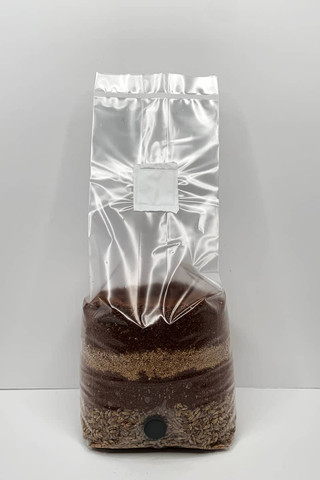
|
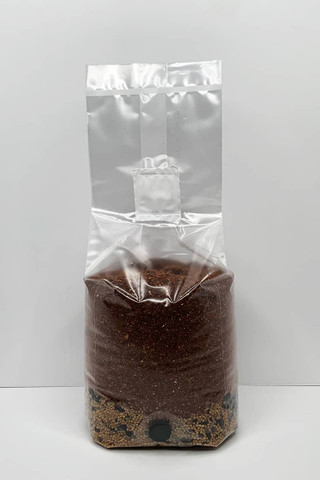
|
|
Rye Grain w/ |
Rye Grain w/ |
Wild Bird Seed w/ |
How do Mushroom Grow Bags Work?
Mushroom grow bags work by providing the ideal conditions for mycelium growth. The mycelium, the vegetative part of a fungus, produces mushroom fruiting bodies, which are harvested and consumed by people. The mushroom substrate in the grow bag serves as a nitrogen rich food source for the mycelium, which grows and colonizes it, producing mushrooms. The bag is inoculated with a spore syringe, liquid culture, or mycelium on agar, and the growth process begins from there.
Mushroom Substrate: The Fuel for Your Fungi
Prepare your substrate carefully to provide the necessary nutrients for your fungi to grow and thrive. The mushroom substrate serves as the fuel that powers the growth of your mushrooms, and choosing the right type is crucial for successful cultivation. Depending on the specific species you wish to grow, there are various options available such as rye grain, sawdust, straw, and more.
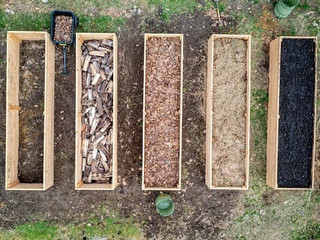
To ensure optimal moisture levels for your mushrooms in a bag, it's essential to properly sterilize your substrate before use. This helps eliminate any potential contaminants that could hinder the growth of your fungi. Sterilization can be done through methods such as pressure cooking or steam pasteurization, depending on the type of substrate you're using.
Once sterilized, you can prepare your mushroom bags by adding the substrate along with mushroom spawn. The spawn acts as a seed for your mushrooms to grow from and is typically mixed thoroughly with the substrate material. It's important to evenly distribute the spawn throughout the bag to ensure uniform colonization.
To add a level of sophistication to your cultivation process, consider using a nested bullet point list:
- Substrate options: Straw, Sawdust, Wood Chips, Coffee Grounds
- Grain: commonly used for species like oyster mushrooms
- Sawdust: ideal for wood-loving varieties such as shiitake
- Sterilization methods:
- Pressure cooking: effective in killing contaminants through high temperature and pressure
- Steam pasteurization: utilizes steam heat to reduce microbial populations
By carefully preparing and sterilizing your mushroom substrate, you create an environment conducive to healthy and fruitful growth. With this step complete, you're now ready to move on to setting up your mushroom grow bag and initiating fruiting conditions without delay or hesitation.
How to Set Up a Mushroom Grow Bag
Let's jump right into the process of setting up your very own mushroom grow bag for a successful cultivation journey. This step is crucial in ensuring the proper growth and development of your gourmet or exotic mushrooms.

To help you understand the process better, let's break it down into a simple table:
| Step | Instructions |
|---|---|
| Step 1 | Choose the right grow bag for your mushroom strain. Consider factors such as size, material, and filter type. Common options include polypropylene bags with self-healing injection ports and filter patches to allow for gas exchange while preventing contamination. |
| Step 2 | Inoculate the bag with a spore syringe or liquid culture syringe through a self-healing injection port. This introduces the desired fungi to the substrate within the bag. Ensure sterile techniques during this step to minimize contamination risks. |
| Step 3 | Seal the bag with micropore tape once inoculated to create a controlled environment inside it. Micropore tape allows for gas exchange while effectively preventing contaminants from entering. |
| Step 4 | Induce fruiting once the mycelium has fully colonized the substrate, increase the temperature, light, and humidity levels to induce fruiting. |
| Step 5 | Harvesting mushrooms: Carefully cut the mushrooms at the stem base, leaving the remaining mushroom mycelium in the bag for extra flushes and harvests. |
Following these steps will set you on the path toward successful mushroom cultivation using an all in one grow bag system.
Now that you have set up your mushroom grow bag, it's time to delve into a comprehensive guide on how to use all in one mushroom grow bags effectively without missing any critical steps in achieving abundant mushroom yields.
Now that you've prepared an environment conducive to healthy and fruitful growth, it's time to focus on setting up a mushroom grow
Comprehensive Guide to Using All In One Mushroom Grow Bags
The comprehensive guide provides valuable insights and techniques for maximizing all in one grow bags lifespan and yield potential for cultivating a variety of delicious and unique mushroom species. These all in one mushroom grow bags are a convenient option for both beginners and experienced growers, as they come pre-sterilized and filled with the necessary growing medium and nutrients.

To help you understand the process better, here is a table outlining the key steps involved in using all in one mushroom grow bags:
| Step | Description |
|---|---|
| 1 | Select the right bag size based on your desired yield and available space. |
| 2 | Inoculate the bag by simply injecting 2-4 ml of spore syringe, liquid culture, or adding mycelium on agar to initiate growth. |
| 3 | Place the bag in a suitable habitat, whether indoors or outdoors in shaded areas. |
| 4 | Cut or puncture the bag for fresh air exchange once colonization is complete. |
| 5 | Move the bag to a bright location with high humidity to encourage fruiting. |
Following these steps will ensure that your mushrooms have optimal conditions for growth and development. It's important to note that proper ventilation and fresh air exchange are crucial during both the colonization and fruiting stages.
Now that you know how to set up your all in one grow bag, let's explore where you should place them to maximize their potential.
Where Do You Put Mushroom Grow Bags?
Find the perfect location to maximize your mushroom harvest by strategically placing your grow bags in environments that maintain consistent temperature and humidity levels. The success of your mushroom cultivation depends greatly on providing the ideal conditions for growth. Whether you choose to keep your grow bags indoors or outdoors, it is crucial to ensure that the temperature range stays between 65°F and 75°F, while humidity levels range from 60% to 80%.
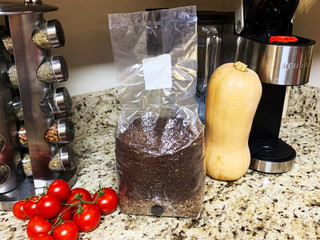
To help you decide where to place your mushroom grow bags, refer to the table below:
| Indoor Locations | Outdoor Locations |
|---|---|
| Closet | Shaded area |
| Pantry | Porch |
| Mushroom tent | Shed |
| Grow cabinet | Greenhouse |
| Grow tent | Consistent environment |
Indoors, a closet or pantry can provide a controlled environment with the right temperature and humidity level. Alternatively, you can use a dedicated space like a mushroom tent, grow cabinet, or grow tent. Outdoors, find a shaded area such as underneath a porch or inside a shed. If you have access to a greenhouse, it can also be an excellent location for growing mushrooms.
Consider these factors when finding the perfect spot for your all-in-one mushroom grow bag:
| Factor | Ideal Range |
|---|---|
| Temperature | 65-75°F (18-24°C) |
| Humidity | 85-95% |
| Light | Low light or indirect natural/artificial light |
Once you have found the perfect spot for your mushroom grow bags, you can proceed to learn about how to fruit mushrooms in them. By following proper techniques and maintaining optimal conditions throughout the fruiting process, you will soon be rewarded with bountiful harvests of gourmet or exotic mushrooms.
How to Fruit Mushrooms in a Grow Bag?
To successfully fruit mushrooms in a grow bag, ensure the environment inside the bag is kept at an optimal temperature and humidity level. This will provide the necessary conditions for your mushrooms to develop and mature.

Once the fully colonized bulk substrate is completely covered with white mycelium, it's time to fruit the mushroom spawn and start the mushroom pinning stage. To trigger mushroom pinning and fruit your bag of fungi, you'll need to provide the right fruiting conditions, including light, air exchange (minimize CO2), and a relatively high humidity level. Simply cut or puncture the bag to increase the fresh air exchange (FAE), mist the bag to maintain a high humidity level, and place the bag in a bright location or use a mushroom grow light. Maintaining the right temperature and humidity is crucial for white mycelium growth and the formation of fruiting bodies.
In order to create these ideal conditions, you can use various methods such as misting, fanning, or providing indirect light. Mist the inside of the bag with water using a spray bottle to increase humidity levels. This will help promote mushroom growth and prevent drying out. Additionally, gently fan the bag a few times a day to improve air circulation, which aids in preventing contamination and promoting healthy mushroom development.
A critical factor in fruiting mushrooms and fruiting bags is maintaining proper temperature levels. Different types of mushrooms have specific temperature requirements for optimal growth and fruiting. For example, oyster mushrooms thrive at temperatures between 60-75°F (15-24°C), while shiitake mushrooms prefer slightly cooler temperatures around 55-65°F (13-18°C). It's essential to research your specific mushroom variety to determine its ideal temperature range.
To better understand how environmental factors impact mushroom growth, consider this emotional response table:
| Environmental Factors | Impact on Mushroom Growth |
|---|---|
| Temperature | Affects fruiting process |
| Humidity | Essential for moisture |
| Light | Triggers fruiting |
| Air Circulation | Prevents contamination |
| Contamination | Hinders mushroom growth |
It may take several days up to a few weeks for the mushrooms to become visible, and as soon as the mushroom gills are fully developed, it's important to harvest them promptly to avoid over-ripening.
By creating favorable conditions within your grow bag, you are ensuring the successful cultivation of gourmet or exotic mushrooms. Once you have mastered this step, you can move on to determining where best to place your grow bags for maximum results.
Troubleshooting Your Mushroom Grow Bag: A Problem-Solving Guide
While troubleshooting common problems in your mushroom cultivation journey, it's important to address issues such as contamination, slow growth, mushroom diseases, and inadequate fruiting. Here are some tips and considerations to help you troubleshoot your mushroom grow bag:

- Contamination: If you notice mold or other foreign substances growing on your substrate, it's likely due to contamination. Make sure you're practicing proper sterile techniques during the inoculation process and maintaining a clean environment. Consider using a higher-quality filter patch or increasing the fresh air exchange to prevent contamination.
- Slow growth: If your mushrooms are taking longer than expected to colonize or fruit, there may be several factors at play. Check the temperature and humidity levels in your growing area as they can significantly impact growth rates. Also, make sure you've provided enough nutrients in the substrate and that it's properly sterilized before inoculation.
- Mushroom diseases: Diseases such as bacterial blotch or green mold can affect the health of your mushrooms. To prevent these diseases, maintain proper hygiene practices throughout the cultivation process. Remove any infected mushrooms promptly to prevent spreading.
- Inadequate fruiting: If you're not seeing adequate fruiting from your grow bag, consider adjusting the environmental conditions. Increase fresh air exchange by cutting or puncturing holes in the bag for better airflow. Make sure the bag is placed in a bright location with high humidity levels for optimal fruiting conditions.
Transition into the next section:
Now that you've familiarized yourself with troubleshooting tips for your mushroom grow bags, let's explore how to craft DIY mushroom grow bags in order to have more control over the cultivation process.
How Quickly Do You Need to Use an All In One Mushroom Grow Bag?
The majority of all in one mushroom grow bags are designed to be used immediately after the autoclave bags have cooled off from the substrate sterilization procedure but can stay fresh for up to a month or longer. To ensure optimal growth and maximum yield across all mushroom growth stages, it is crucial to promptly inoculate the bag and meticulously follow the mushroom growing instructions. Once you have inoculated the grow bag with mushroom spores via a syringe or liquid culture syringe, you will need to incubate it for several weeks between 65°F and 75°F to allow the mycelium to fully colonize the bulk mushroom substrate. After that, the mycelium block will be ready to introduce into a fruiting environment within a few days and will be ready for harvest in a couple of weeks.
Disadvantages of All In One Mushroom Grow Bag Fruiting
- Yield may be limited: A single grow bag may not yield as much after harvesting versus growing with a monotub, mushroom grow tent, or martha tent, but this can be offset by fruiting the bag inside a simple shotgun fruiting chamber with perlite.
- Contamination risk: If the bag is not properly sealed or if the growing conditions are not ideal, contamination can occur, ruining the mushroom harvest.
- Limited types of mushrooms: Some bags are specifically designed for certain mushroom varieties, limiting your options for growing different types of mushrooms.

Do Mushroom Bags Need to Breathe?
The mushroom grow bags do need to breathe and require proper ventilation during both the colonization and fruiting stages. During the colonization stage, the filter patch on the bag will provide an optimal gas exchange. During the fruiting stage, you'll need to provide air exchange by cutting or puncturing the bag to allow fresh air to circulate. Offering fresh air exchange during these crucial phases helps prevent mold and bacteria from growing inside the bag.
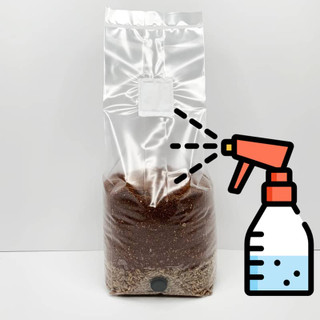
How To Water Grow Bags?
Mushroom bags do not typically require watering, as the substrates occupying the inside of the bag will retain moisture and provide the necessary hydration for the mushrooms to grow. However, it is crucial to keep an eye on the H2O moisture content inside the mushroom bag to guarantee optimal mushroom growth accompanied by an abundant yield. If you notice that the substrate is starting to dry out, you can use a mister to mist the bag with distilled water to help increase the relative humidity inside the grow bag.
Crafting DIY Mushroom Grow Bags: A Practical Guide
Discover the joy of creating your personalized bags for cultivating an abundant harvest of delicious fungi. Crafting DIY mushroom grow bags are a practical and rewarding way to ensure that you have full control over the substrate and spawn used in your mushroom cultivation process.
To begin, gather all the necessary materials. You'll need high-quality polypropylene bags, typically around 14 inches by 8 inches in size, as well as a substrate mixture of your choice. Popular options include sawdust, straw, coffee grounds, or a combination thereof. You'll also need mushroom spawn, which serves as the inoculant to kickstart the growth of mushrooms.

Once you have your materials ready, sterilize them thoroughly to prevent contamination. This can be done through methods such as boiling or pressure cooking. After sterilization, allow them to cool down before proceeding further.
Next, fill each bag with your chosen substrate mixture and evenly distribute the mushroom spawn throughout. Seal the bags using a heat sealer or by folding and twisting them tightly shut to retain moisture and create an optimal growing environment for the mycelium.
Place these bags in a warm and dark area where they can incubate undisturbed for several weeks until fully colonized. During this period, monitor temperature and humidity levels closely to ensure optimal conditions for mycelium growth.
Once colonization is complete and white mycelium has spread throughout the bag's contents, it's time to introduce more oxygen by making small holes in the bag or opening it slightly. This will initiate fruiting and allow mushrooms to develop.
Crafting DIY mushroom grow bags offers you complete control over every aspect of your cultivation process while providing an opportunity for personalization based on your preferred ingredients and techniques. It's a fulfilling project that allows you to enjoy not only delicious gourmet or exotic mushrooms but also the satisfaction of nurturing their growth from start to finish.
Now that you've learned how to craft your mushroom grow bags, it's time to explore the simplicity and efficiency of all in one mushroom grow bags in our next section. These innovative bags simplify the cultivation process even further, making it easier than ever to enjoy a bountiful harvest of mushrooms.
Wrapping Up: The Simplicity and Efficiency of All In One Mushroom Grow Bags
Embrace the journey of mushroom cultivation and revel in the simplicity and efficiency of using all in one grow bags to cultivate a wide variety of delicious fungi right in your own home! These convenient bags are designed to simplify the process, making them accessible to both beginners and experienced growers.
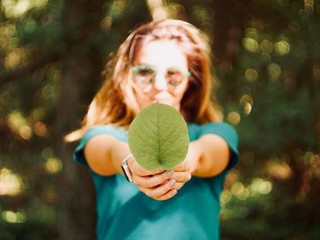
With all in one grow bags, you don't need to worry about sterilizing substrate or finding the perfect growing medium. Everything you need is conveniently packed into one bag.
The beauty of these grow bags lies in their pre-sterilized nature, which eliminates the need for time-consuming sterilization processes. The bags are filled with a carefully curated mixture of nutrient-rich materials like coco coir and cow manure compost mixtures that provide an optimal environment for mushroom growth. Additionally, they're inoculated with a spore syringe, liquid culture (LC), or mycelium on agar to jumpstart the colonization process.
Once your all in one grow bag is ready, proper ventilation and fresh air exchange become crucial during both the colonization and fruiting stages. It's important to cut or puncture the bag for fresh air exchange and place it in a bright location with high humidity for fruiting. While these bags don't typically require watering, misting them with distilled water can help increase humidity if needed.
By using all in one grow bags, you can eliminate many variables that often lead to contamination or limited yields. The pre-sterilized nature of these bags significantly reduces contamination risks compared to traditional cultivation methods. Additionally, their compact size makes them ideal for indoor cultivation while still providing ample space for mushroom growth.
All in one mushroom grow bags offer a convenient and efficient solution for cultivating gourmet or exotic mushrooms at home. Embrace this journey as you explore different varieties of mushrooms and enjoy the simplicity that these grow bags bring to your cultivation process. Get started today by visiting Funguy Grow Supply where you'll find everything you need to embark on your mushroom growing adventure!
Cultivate Success with Top Rated Mushroom Grow Bags at FunGuy Grow Supply
Ready to start growing your own mushrooms at home? Visit FunGuy Grow Supply now and explore our top-quality grain spawn, and All In One Mushroom Grow Bags, mushroom grow kits that make cultivating gourmet or exotic mushrooms a breeze! Shop now to start your mushroom cultivation adventure today!
Frequently Asked Questions

Can I reuse a mushroom grow bag?
Yes, you can reuse a mushroom grow bag. However, it's important to properly sanitize the bag before reusing it to prevent contamination. Start by thoroughly cleaning and disinfecting the bag with a bleach solution or other suitable sterilizing agent. Make sure to rinse it well afterward to remove any residue.
Additionally, inspect the bag for any signs of wear or damage that could compromise its integrity. By following these steps, you can safely reuse your mushroom grow bag for future cultivation projects.
How long does it take for mushrooms to grow in a grow bag?
Mushrooms typically take around 2-4 weeks to grow in a grow bag. This timeframe can vary depending on the specific type of mushroom, environmental conditions, and the quality of the grow bag. During this period, the mycelium (the vegetative part of the fungus) colonizes the substrate within the bag.
Once colonization is complete, mushrooms start forming and will continue to develop until they reach maturity. Monitoring temperature, humidity, and proper care are crucial factors for successful mushroom cultivation.
Can I grow multiple types of mushrooms in one grow bag?
Yes, you can grow multiple types of mushrooms in one grow bag. This is possible because different mushroom species have similar growing requirements, such as temperature and humidity. However, it's important to select compatible mushrooms that thrive together and avoid combining aggressive species that could outcompete others.
Additionally, it's crucial to provide ample space for each type to prevent overcrowding and ensure optimal growth. Follow proper sterilization techniques and maintain a suitable environment for the successful cultivation of multiple mushroom varieties in a single grow bag.
Can I grow mushrooms indoors using a grow bag?
Yes, you can grow mushrooms indoors using a grow bag. Grow bags provide a suitable environment for mushroom cultivation by maintaining ideal humidity levels and allowing proper air circulation. They're designed with a sterile substrate that's enriched with essential nutrients for the mushrooms to thrive. The bags also have filters to prevent contamination while still allowing gas exchange.
This method is convenient and efficient, making it a popular choice among home growers who want to enjoy fresh, gourmet, or exotic mushrooms year-round.
How do I know when it's time to harvest the mushrooms from the grow bag?
To determine when it's time to harvest mushrooms from your grow bag, observe their growth and development. Look for fully formed caps that have opened up, indicating maturity. The cap edges should be lifted slightly, and the gills underneath should be visible but not overly exposed or discolored.
Additionally, check if the veil beneath the cap has broken, revealing the gills. Harvesting at this stage ensures optimal flavor and texture.
References
- Stamets P. (1993). Growing gourmet and medicinal mushrooms: a companion guide to the mushroom cultivator. Ten Speed Press.
- Hoa, H. T., & Wang, C. L. (2015). The Effects of Temperature and Nutritional Conditions on Mycelium Growth of Two Oyster Mushrooms (Pleurotus ostreatus and Pleurotus cystidiosus). Mycobiology, 43(1), 14–23. https://doi.org/10.5941/MYCO.2015.43.1.14
- Hoa, H. T., Wang, C. L., & Wang, C. H. (2015). The Effects of Different Substrates on the Growth, Yield, and Nutritional Composition of Two Oyster Mushrooms (Pleurotus ostreatus and Pleurotus cystidiosus). Mycobiology, 43(4), 423–434. https://doi.org/10.5941/MYCO.2015.43.4.423
- Suwannarach, N., Kumla, J., Zhao, Y., & Kakumyan, P. (2022). Impact of Cultivation Substrate and Microbial Community on Improving Mushroom Productivity: A Review. Biology, 11(4), 569. https://doi.org/10.3390/biology11040569
- Pardo-Giménez, A., Pardo, J. E., Dias, E. S., Rinker, D. L., Caitano, C. E. C., & Zied, D. C. (2020). Optimization of cultivation techniques improves the agronomic behavior of Agaricus subrufescens. Scientific reports, 10(1), 8154. https://doi.org/10.1038/s41598-020-65081-2
- Bellettini, M. B., Fiorda, F. A., Maieves, H. A., Teixeira, G. L., Ávila, S., Hornung, P. S., Júnior, A. M., & Ribani, R. H. (2019). Factors affecting mushroom Pleurotus spp. Saudi journal of biological sciences, 26(4), 633–646. https://doi.org/10.1016/j.sjbs.2016.12.005

